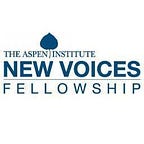Writing an op-ed: Targeting an audience and deciding on the call to action
An audio version is available at SoundCloud.
Holly: If you plan to write an op-ed, it is important to have a goal in mind. Are you trying to influence policymakers? Local community members? Researchers? Funders? What do you want them to do?
Welcome to the Aspen Institute New Voices Fellowship Tips! My name is Holly Kearl and I manage the alumni of our fellowship program. Today, I am talking with our Alumni Council members about their tips and experiences with deciding on the audience for an op-ed and crafting a call to action. Jacqueline Muna Shea, can you please speak to what you do when you write?
Jacqueline: Most of my pieces have been targeted towards policy makers, locally and globally on financial market development and other economic development policy issues. I try to always come up with recommendations for their consideration and action. After publication, I send them the article in order to start the conversation and position myself as the person who can help them. I also target people within industry who can nudge lawmakers on my behalf. It is easy to track progress in Uganda as I get calls from policy makers asking for more information. At a global level, Project Syndicate has been great at reaching varied audiences, but also high level global policy makers. The editors are strict with their rules so by the time a piece is published, the intent of the article seems more clear than other publications.
Holly: Yes, Project Syndicate has been a really effective partner for Aspen New Voices. Sathya Raghu Mokkapati, what has been your experience with this?
Sathya: A lot of times, my OpEds are born from situations that I see and things which worry me. I ask myself, “Can I live with the status quo?”. If the answer is a strong ‘NO’, then I think of who can really change this. It is easy to say “ everyone”. But I push myself towards answering the question “Entrepreneurs ? Policy makers ? Civil Society? Federal bank? Think tanks? Philanthropies?”
I write many pieces in one specific Indian outlet ‘BusinessLine’ because many things that I want to change should be heard by policy makers. The ones that startups can do will be pitched to another outlet. This helps me reach the audience to whom I want to give a call for action.
Holly: That’s great, and you’ve had a lot of success with this, haven’t you? Do you mind sharing one example of the many outcomes you’ve had from writing for local papers?
Sathya: I happened to write a piece on why and how Nabard , a $50Bn Apex Agri financer, can get more startup friendly. It was published in an online outlet in India and Nabard reached out to talk about changing their policies.
Holly: This is a reminder that while getting a piece published in the New York Times may be a dream for a lot of people, you may have more impact by being published in other outlets. Local newspapers can be really influential, for instance, especially when you’re writing about changing local policies or practices. So, often, it is more important to think about your audience and what they read instead of the potential cache of the name of the outlet. Esther Ngumbi, how do you approach the audience?
Esther: My pieces mostly target other researchers, funders to food security initiatives and other global challenges we all face, private partners, African Governments and basically everyone. I do believe we all have a role to play, whether I am writing about climate change, the degraded soils, empowering youth, unleashing the power of women etc etc.
Holly: True. Gulrez Shah Azhar what has been your experience?
Gulrez: Initially, I had struggled with this and sometimes still do. I write on climate change and it seems like such an intractable problem :( . I wasn’t clear about the end goal. But, big or small, there has to be a concrete call to action — for researchers to investigate relationships, for policy makers to do something and so on.
Holly: That’s true and that can be a really hard part, making your call to action clear and doable. But we need to do it if we want to see real change. So, for instance, instead of saying, “Let’s all end world hunger,” which is too vague and not doable for any one person, say something like, “Donate five cans of food each month to your local food bank,” which is very clear and it may be doable for a lot of readers. This has been your experience, right ElsaMarie D’Silva?
Elsa: Yes. I find you must be absolutely clear who your piece is targeted at — a domestic or international audience or if it is aimed at policy makers. This will also dictate the outlet you will choose to publish your piece. Accordingly you will craft your call to action. Be as specific and clear as possible.
